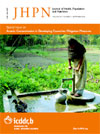
|
The Journal of Health, Population and Nutrition
icddr,b
ISSN: 1606-0997
EISSN: 1606-0997
Vol. 22, No. 4, 2004, pp. 404-412
|
 Bioline Code: hn04049
Bioline Code: hn04049
Full paper language: English
Document type: Research Article
Document available free of charge
|
|
|
The Journal of Health, Population and Nutrition, Vol. 22, No. 4, 2004, pp. 404-412
| en |
Cost of Delivering Child Immunization Services in Urban Bangladesh: A Study Based on Facility-level Surveys
Khan, M. Mahmud; Khan, Suhaila H.; Walker, Damian; Fox-Rushby, Julia; Cutts, Felicity & Akramuzzaman, S.M.
Abstract
This facility-based study estimated the costs of providing child immunization services in Dhaka,
Bangladesh, from the perspective of healthcare providers. About a quarter of all immunization (EPI)
delivery sites in Dhaka city were surveyed during 1999. The EPI services in urban Dhaka are delivered
through a partnership of the Government of Bangladesh (GoB) and non-governmental organizations
(NGOs). About 77% of the EPI delivery sites in Dhaka were under the management of NGOs,
and 62% of all vaccinations were provided through these sites. The outreach facilities (both GoB and
NGO) provided immunization services at a much lower cost than the permanent static facilities. The
average cost per measles-vaccinated child (MVC), an indirect measure of number of children fully
immunized (FIC__the number of children immunized by first year of life), was US$ 11.61. If all the
immunization doses delivered by the facilities were administered to children who were supposed to be
immunized (FVC), the cost per child would have been US$ 6.91. The wide gap between the cost per
MVC and the cost per FVC implies that the cost of immunizing children can be reduced significantly
through better targeting of children. The incremental cost of adding new services or interventions with
current EPI was quite low, not significantly higher than the actual cost of new vaccines or drugs to be
added. NGOs in Dhaka mobilized about US$ 15,000 from the local community to support the immunization
activities. Involving local community with EPI activities not only will improve the sustainability
of the programme but will also increase the immunization coverage.
Keywords
Immunization; Costs and cost analysis; Health facilities; Non-governmental organizations; Community participation; Bangladesh
|
| |
© Copyright 2004 - The Journal of Health, Population and Nutrition
Alternative site location: http://www.jhpn.net
|
|
